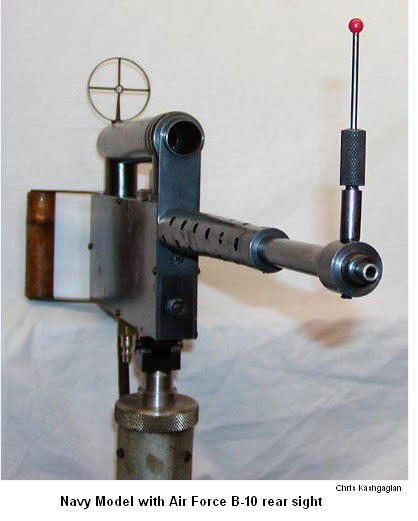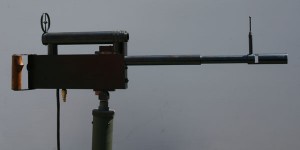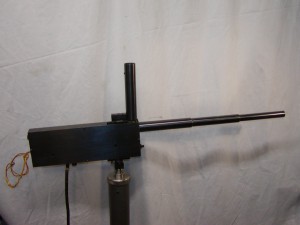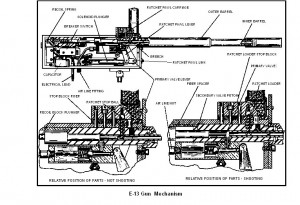The company had two main customers for its air machine guns; the Army Air Forces and the United States Navy, and each had its own requirements. The following discussion of features of the various models is based on the respective manuals, and actual production configurations may have varied.
The Navy Model
The Navy model, Type N, officially known as Device 3-A-8, Air Machine Gun, may have been the same as MacGlashan’s commercial model. It can be identified primarily by the slightly-tapered perforated barrel jacket that covers the rear two thirds of the barrel. This was purely cosmetic, since a compressed air gun is self-cooling by virtue of the expanding air during firing.
Being a hand-aimed weapon, this gun was characterized by spade grips and a push-button trigger at the rear of the receiver. It also had a horizontal tubular BB magazine mounted above the receiver. This magazine actually consisted of two concentric tubes, with the BBs stored in the annular space between the inner and outer tubes. This configuration permitted the installation of an E-5 telescopic sight inside the inner tube, so the gunner was actually sighting through the magazine.

The trigger switch and the interrupter switch were combined into a single assembly that was characterized by open contacts at the end of leaf springs, similar to relay contacts. The interrupter contacts were pushed into contact with each other by a rod projecting downwards from the recoil block.
The primary air valve closure consisted of a cylindrical part roughly resembling a golf tee (with a blunt end), restrained with a single cantilevered wire. This configuration insured that the valve would be kept closed by the air pressure behind it were its spring to break.
The Navy purchased 424 of these guns for just over $110,000, or about $259 per set. How the unit cost was allocated between the gun, the mount and the power supply is not known.
The Aerial Gunnery Trainer Type E-3
The AAF apparently initiated procurement of its E-3 Aerial Gunnery Trainer in 1941, since it was declared a standard AAF item on July 28, 1941. It was a redesigned version of MacGlashan’s commercial model, modified to eliminate some unsatisfactory characteristics (probably having to do with timing and consistency of rate of fire) . The first aerial gunnery school was being set up at Las Vegas that summer, and the initial purchase was very likely part of the equipping of that school, and of the others soon to follow..
The E-3 resembled the Navy model externally, except that the perforated barrel jacket was absent, and a tubular extension was added to the muzzle.
In this gun, the primary valve exit is closed by a simple steel ball held in place by a single loop cantilevered wire spring. If this spring were to break, the ball would be free to roll around inside the valve body, permitting a continuous flow of air to escape.
The E-3 served throughout the war, and was declared obsolete on November 6, 1945.
The Aerial Gunnery Trainer E-13
The E-13 was a variation of the E-3 intended for use in fixed gunnery training for fighter pilots. It was mounted at the front of a stripped-down Link trainer-like cockpit. The student “flew” the trainer to aim and fire at a target that moved along a track in front of the trainer. A reflector sight was mounted above the instrument panel, and aligned with the gun.
Since there was no need for sights mounted on the gun itself, a single-tube magazine was oriented vertically, which probably increased ammunition utilization and facilitated loading. Also, this model had no spade grips or trigger on the back, since the trigger switch was mounted on the pilot’s stick grip.
There were internal changes as well, mostly having to do with electrical components and the means of actuating them. On the assumption that later models of the gun contained improvements designed to correct shortcomings encountered in earlier models, it appears that there may have been problems with electrical contact life in the earlier design, perhaps due to arcing and pitting and perhaps breakage due to metal fatigue. At any rate, the E-13 used an enclosed acro switch with a capacitor connected across the contacts to reduce arcing. Acro snap switches were designed to have a snap action and to provide a wiping motion between the contacts as they opened and closed, helping to keep them clean and smooth. They were also designed for long life under demanding conditions.
A more complicated latching mechanism was added to the underside of the recoil block to operate the acro switch at the correct points in the firing cycle. It was presumably more reliable and less subject to breakage and maladjustment than its predecessor.
The E-13 was declared standard on June 1, 1943 and obsolete on November 6, 1945. A recorded serial number on a specimen examined suggests that at least 444 of these guns were made.



